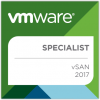 Reading Time: 3 minutes
Reading Time: 3 minutesThe Link Layer Discovery Protocol (LLDP) is a vendor-neutral link layer protocol used by network devices for advertising their identity, capabilities, and neighbors on an IEEE 802 local area network, usually with Ethernet standard. Compared to Cisco Discovery Protocol (CDP) it’s not proprietary and can be used from different vendors.
VMware vSphere adds LLDP capability in the Distribuited Virtual Switches (DVS). CDP it’s also available both in DVS, but also in standard virtual switches (by default it’s enabled in listen mode).












